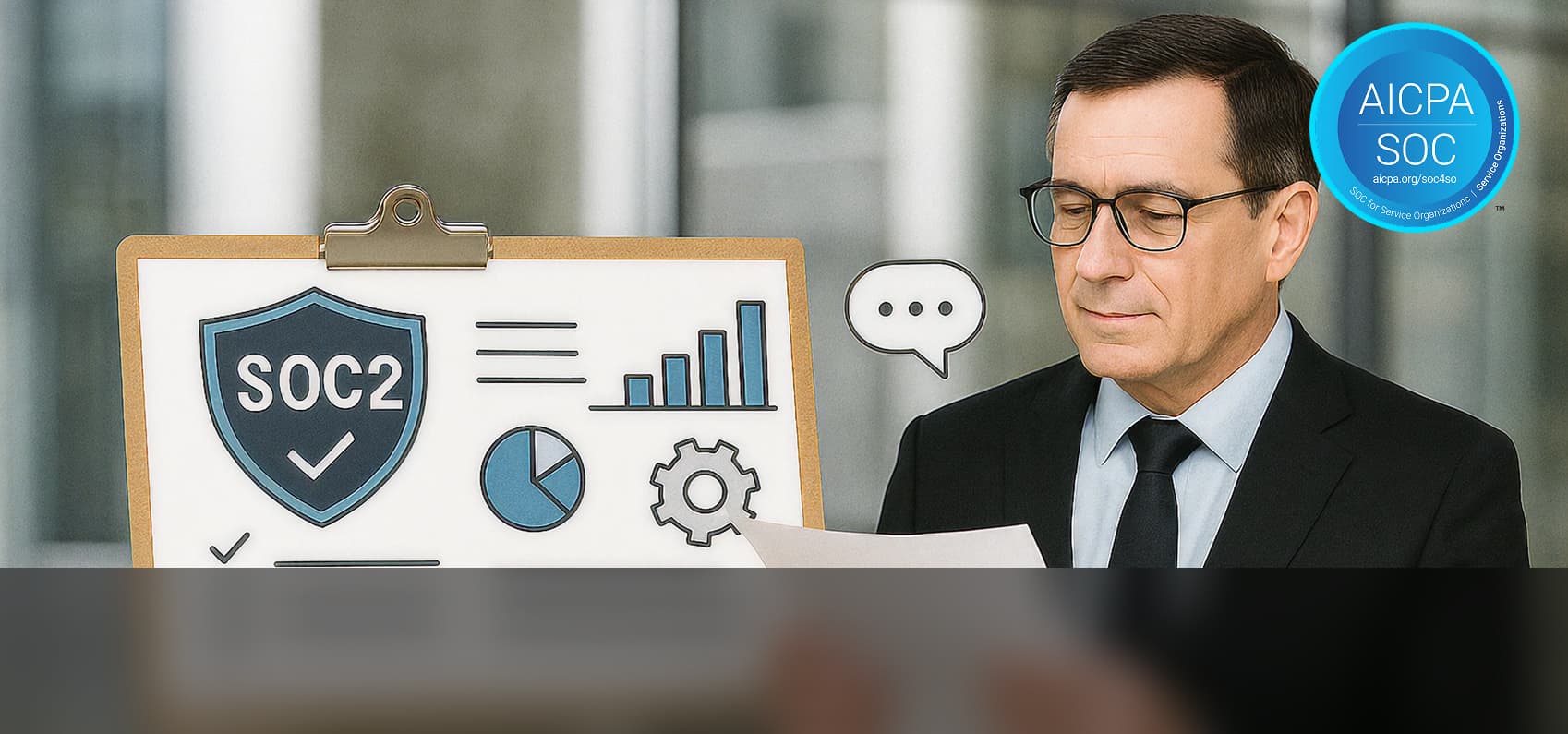What Is SOC 2?
SOC 2 is an independent certification that proves your company securely manages customer data. It’s not a government regulation, but a widely recognized standard created by the American Institute of Certified Public Accountants (AICPA) for technology and service organizations.
In simple words, SOC 2 shows your clients and partners that you take data security, privacy, and reliability seriously, and that an internally acclaimed third party has verified it.
What Are the SOC 2 Trust Service Criteria and Why Do They Matter?
SOC 2 compliance is built around five “Trust Service Criteria” (TSC), which are the metrics auditors use to evaluate your company’s controls:
- Security (mandatory): Are your systems protected against unauthorized access?
- Availability: Are your services reliably available for customers?
- Processing Integrity: Is your data processed accurately and on time?
- Privacy: Are you handling personal data transparently and responsibly?
For customers, these criteria mean peace of mind: They know you’re committed to keeping their data safe, your services are reliable, and you’re transparent about how you handle information.
What Do Businesses Need to Do?
SOC 2 is not just the responsibility of the IT department. Every business unit plays a role:
- Sales: Must understand SOC 2 basics to answer customer questions and provide the SOC 2 report during vendor reviews. It will help you in shortening the sales cycles and win bigger deals.
- Product: Needs to ensure security and privacy are built into product development. This includes secure coding, regular updates, and documenting how customer data is handled.
- HR: Is responsible for background checks, security training, and access management for employees. HR must ensure only authorized personnel can access sensitive data. Other teams like Legal, Finance, and Operations, also need to update policies, review vendor contracts, or support compliance documentation.
Answering the Common Questions on Investing the Time, Money, and Effort
1. How long does SOC 2 take?
The process typically takes 3–12 months, depending on your company’s size, existing controls, and whether you’re pursuing a Type I (Limited in scope and short-term) or Type II (comprehensive and long-term) report.
2. What does it cost
Costs depend on your company and the type you choose and include readiness assessments, remediation, tools, and auditor fees. The investment depends on your company’s complexity and how much work is needed to meet your requirements.
3. What’s involved?
- Gap analysis and remediation of policies and controls.
- Continuous monitoring and evidence collection.
- Annual audits and ongoing updates as your business grows.
Executive Action Plan For SOC 2
Make Security a Business Priority: Make it clear that protecting customer data is a top organizational goal, not just an IT task. Your leadership sets the tone for company-wide commitment.
Break Down Silos: Ensure seamless collaboration between sales, product, HR, and compliance teams. SOC 2 success depends on cross-functional ownership and clear communication.
Invest Wisely and Early: Allocate sufficient budget and resources upfront for readiness assessments, remediation, and audits. Delaying investment often leads to higher costs and lost opportunities.
Demand Transparency and Accountability: Require regular status updates on SOC 2 progress, risks, and remediation efforts. Visibility keeps the process on track and prevents surprises
Leverage SOC 2 as a Growth Lever: Use your SOC 2 certification proactively in sales conversations and marketing to build trust, shorten sales cycles, and differentiate your brand.
Plan for Continuous Improvement: SOC 2 is not a one-time thing. Adapt to ongoing monitoring, training, and process refinement into your BAU to stay ahead of evolving risks and customer expectations.
Third-Party and Vendor Risk Management
SOC 2 places significant emphasis on managing third-party risk because vendors often have access to sensitive systems or data, and any lapse on their part can expose your organization to compliance failures, breaches, or reputational harm.
How SOC 2 Guides Vendor Risk Management:
1. Vendor Due Diligence:
Before engaging with any vendor, conduct thorough due diligence. This means assessing their security posture, reviewing their SOC 2 reports (if available), checking compliance history, and evaluating their financial stability. For vendors with access to your core systems or customer data, this step is non-negotiable.
2. Contractual Safeguards:
Every vendor relationship should be governed by a detailed contract or service-level agreement (SLA). These documents must clearly state security requirements, data protection obligations, incident response procedures, and compliance expectations. Specify performance targets and consequences for non-compliance to ensure accountability.
3. Continuous Monitoring:
Regularly review vendor SOC 2 reports, conduct risk assessments, and track changes in their security practices. Continuous monitoring helps you identify and respond to new vulnerabilities or compliance gaps as they arise.
4. Incident Response Collaboration:
Work with vendors to establish joint incident response plans. Both parties should know their roles if a security event occurs, ensuring a coordinated and timely response that limits damage and meets regulatory requirements.
5. Documentation and Record Keeping:
Maintain detailed records of all vendor assessments, contracts, performance reviews, and incidents. This documentation not only streamlines your own audits but also increases transparency and accountability across your vendor ecosystem.
6. Mapping Risks to Controls:
Identify, score, and map each vendor risk to specific SOC 2 control domains. Use tools or platforms to track these mappings and ensure every vendor-related risk is continuously monitored and evidence-backed for audit readiness.
What Happens After the SOC 2 Audit?
Achieving SOC 2 compliance is a major milestone, but it’s not the finish line. The factual value and the biggest challenge is in maintaining compliance year after year as your business, technology, and risks develop.
Key Elements of Ongoing SOC 2 Compliance:
-
Continuous Control Monitoring: Implement systems and processes to continuously monitor the effectiveness of your controls. This means regular internal audits, automated evidence collection, and real-time alerts for any deviations or incidents.
-
Periodic Vendor Reviews: Schedule regular reviews of your vendors’ security practices and SOC 2 status. Update risk assessments and adjust controls as vendors, technologies, or business needs change.
-
Policy and Process Updates: As your organization grows or regulations change, update your security policies, procedures, and documentation. This ensures your controls remain relevant and effective.
-
Annual Audits: Prepare for annual SOC 2 audits by maintaining a “compliance-ready” posture at all times. This reduces the scramble before audits and demonstrates a culture of ongoing security and accountability.
-
Evidence Chain Maintenance: Keep a robust, continuously updated evidence chain for all controls and vendor interactions. This not only simplifies audits but also provides defensible proof of compliance in case of incidents or inquiries.
-
Training and Awareness: Regularly train employees and key vendors on security best practices, incident response, and compliance requirements. A well-informed team is your first line of defense.
Conclusion
SOC 2 is a business enabler, not just a technical hurdle. With executive buy-in and cross-functional support, it can accelerate sales, strengthen customer trust, and set your company apart in a crowded market.






Your email address will not be published. Required fields are marked *